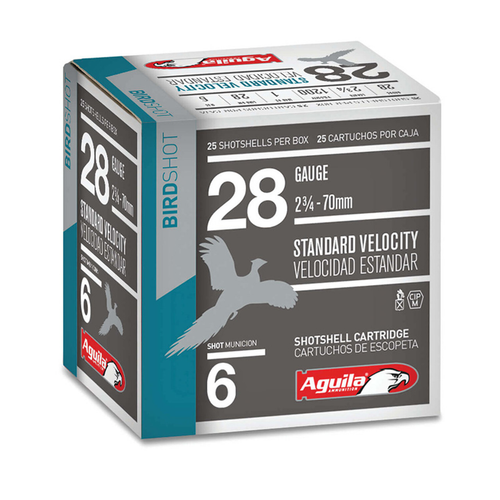28 Gauge Shells
28-Gauge Shotgun: In Depth
Seeing as it’s not the smallest (and definitely not the biggest), the 28-gauge shotgun gets passed over by many folks. One could argue that it’s just another oddball holdover from the olden days–when bore sizes were all over the place–and it won’t do anything that a lightly-loaded 12 or 20 can’t. On the other hand, the fact that so many shotguns and such a wide variety of loads are still produced should give evidence to the contrary.
Like most other shotgun gauges, it’s been around forever–likely the 1850s or earlier. However, if you’re talking about somewhat-modern loads, the aughts (first decade of the 1900s) is when the US first got a taste of this gauge. 1903 is frequently given as the start date for this small bore’s popularity, since Parker Brothers began chambering a 28-gauge gun here in the states that year. Given that Winchester had chambered a pump in 28-gauge by 1937, it wasn’t going anywhere, either. Folks liked the low recoil and lightweight guns for hunting small upland game, albeit in fairly close-up situations.
New loads and alternative shot metals pulled 28-gauge into the future many years later. 3” chambers also expanded the possibilities even further. Though the original mission–hunting small upland game–hasn’t really changed, there are now commercial turkey loads, not to mention all the clay target loadings. There are also folks putting 28-gauge slugs to work by taking medium-sized game. Time and technology have guaranteed a second act for the 28-gauge shotgun, so it may be worth a look after all.
28-Gauge Shotgun: Guns
Overall, shotgun selection and availability tends to narrow a bit as you move down in bore size from 12-gauge. However, there’s still plenty of manufacturers offering a 28-gauge shotgun for sale–including a great selection of semi-autos. In fact, it might be easier to find a semi-auto than a pump, as far as this gauge is concerned. As usual, some of the priciest shotguns are the premium break-actions–either side-by-side or over-under. Still, the market has new-manufactured options to fit most budgets, regardless of whether you’re looking for a beater or something with a little more sophistication. All of the usual players are well represented, from Stoeger to Browning, Mossberg, CZ-USA, Beretta, Benelli, and others.
Break-Action
- Browning Citori Over/Under
- CZ-USA Sharptail
- Stevens 555
- Beretta 486 Parallelo
Semi-Auto
- Benelli Super Black Eagle
- Beretta A400
- Mossberg SA-28
Pump-Action
- CZ-USA 628 Field Select
Why Choose a 28-Gauge Shotgun?
This is the smallest of the shotgun “gauges,” though the .410 bore is even smaller (just not measured in “gauge”). Many folks believe this to be the lower limit for shotgun effectiveness, whether it be for hunting or shooting at sporting clays. The truth is, there’s a lot of utility in a modern 28-gauge, particularly a 3”-chambered model. Like the 20-gauge, it can absolutely punch above its weight class with the longer chamber. However, it’s not going to do all the same tasks that a 12-gauge is capable of, so keep this mind. For the most part, this shotgun is best suited to hunting small upland game and breaking clay targets.
Hunting
- Pheasant, dove, quail, and other small birds in the upland game category. There are also turkey loads out there.
- Generally, waterfowl are not hunted with a 28-gauge shotgun, but it’s possible to do up close.
- Slug loads are available that will work on medium-sized game at short ranges. However, 28-gauge shotguns are not universally allowed for this purpose in all 50 states.
Sport Shooting
- Yes, you can shoot clays with a 28-gauge! There’s plenty of sporting loads available, too.
- Hardly any recoil whatsoever.
28-Gauge Shotgun: Ammo Brands and Loadings
28-gauge loadings include either shot cups or slugs, however, shot sizes are somewhat limited in this gauge. Ammo loaded by the big guys (Federal, Remington, Winchester, Fiocchi) typically ranges from #9 down to #3. Shot is effective on small birds–typically upland game–while slugs are capable of taking small to medium game at somewhat limited ranges. As with the 20-gauge, 3” chambers have definitely helped the 28-gauge stay relevant in the 21st century, and there are a variety of both turkey and target loads that take advantage of this extra room.
28-Gauge Shotgun: Frequently Asked Questions
The 28-gauge is roughly .55 caliber (vs. .410) and can hold more shot and powder. It’s generally considered more useful since you can shoot sporting clays as well.
Loads are available for all manner of small upland game, such as quail, pheasant, grouse, and woodcock.
Turkey loads are available, many in the longer 3” shell length.
Slug loadings are capable of taking some medium game at close range (when and where legal).
With a slug, you’re launching a .55 caliber projectile @ 1,200/fps+, so probably!
Don’t use shot loads for this purpose.





